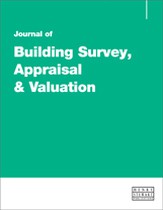Structural movement and defects in traditional Scottish residential property
Abstract
Structural movement can be a source of great concern to the purchasers and owners of historic buildings. Is this concern generally justified or exaggerated? In this overview of the topic, the author provides some advice on the assessment of traditional buildings, distinguishing between the role of the building surveyor and that of the structural engineer, and reviews some key issues including: the inevitability that buildings will be subject to movement (even modern well-engineered buildings); the advantages of flexibility provided by lime mortars in traditional buildings; the composite nature of traditional buildings and the interface between masonry and timber framed elements resulting in cracking that may not be of great concern, the implications of ill-advised alterations; the psychology of cracks in building leading sometimes to needless anxiety; some case studies illustrating that some traditional buildings may conceal serious defects; and others that superficially appear to be in a parlous state, but may in fact be stable. The use of steel in hostile environments may give a false sense of security as a replacement for decayed timbers.
The full article is available to subscribers to the journal.
Author's Biography
David Gibbon is a chartered building surveyor and building engineer based in Edinburgh but practising throughout Scotland and the UK. He is one of the founding directors of GLM, a mixed practice of building surveyors, architects and project managers with a particular specialism in due diligence in relation to heritage-constrained buildings and their adaptive reuse. He has been responsible for major projects to some of the finest buildings in Scotland and is supported by a highly experienced professional and technical team.
Citation
Gibbon, David (2013, June 1). Structural movement and defects in traditional Scottish residential property. In the Journal of Building Survey, Appraisal & Valuation, Volume 2, Issue 2. https://doi.org/10.69554/IKEZ2842.Publications LLP
